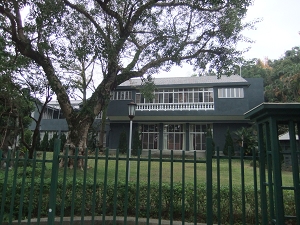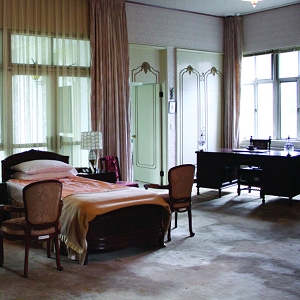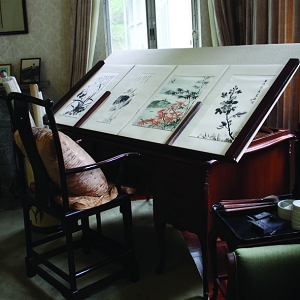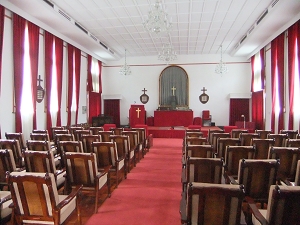Former official residence of Chiang Kai-shek now a token of history
By Psyche Cho Located in Shilin District, Taipei, the principal building of the Residence, a deep-green two-story house of wood and reinforced concrete, is where the then First Family lived and received distinguished guests through an era that was critical to the fate of the Republic of China (ROC). The couple moved into the Residence in 1950 after Chiang resumed his position as head of the state. They spent 26 years in the abode until Chiang passed away April 5, 1975, after which Madame Chiang moved to the United States. The lush green area surrounding the residence was opened to the public in 1996 after being sequestered more than 40 years. After undergoing repair work that was finished at the end of November 2009, the main hall of Shilin Official Residence has been open to the public since January 2, 2011. “What matters is not the architecture itself but those who resided in it,” noted President Ma Ying-jeou in the unveiling ceremony last year. He went on to say that he hoped that future generations would have the chance to gain a perspective on what happened in the past through visiting the historic site. The site covers four historic buildings—the main hall, a guest house, the Ciyun Pavilion and the Victory Chapel—and also includes several parks, making it an ideal place for visitors to relax and enjoy a few hours of leisure. It’s notable that structures throughout the residence, from the main hall to the camps for guards and police, are all painted in blackish green to help them blend into the background and therefore enhance security. President and Madame Chiang lived a splendid and poetic life tied closely to epochal historic events during their days at the Residence. Retired deputy head of the National Security Bureau Chen Tsung-tsui gave a detailed account of their lives in the official abode in his memoirs. Chen notes that the Shilin Official Residence consists of two parts: the mountain area and the ground area. The former was stationed by guard troops, accounting for 20 hectares, and the latter was planned for residence, taking up an area of 5.2 hectares. The current area of the Shilin Official Residence was assigned to the governor-general of Taiwan during the Japanese colonial era for horticultural purposes. It was later taken over by the provincial government after Taiwan Restoration and is now overseen by the Taipei City Government. Inside the main hall, the western-styled building is decorated with traditional Chinese installations. Visitors usually waited at the entrance hall until being led in to see then President Chiang, passing along a hallway in which hung several paintings done by Madame Chiang. The small living room on the first floor was used for meeting and family gatherings. Above the grate hangs a portrait of Chiang’s mother, which shows Chiang’s filial obedience. The Ciyun Pavilion was also named to memorialize Chiang’s mother, notes Chen in his book. Meanwhile, Soong also loved movies, chess and floral art. Watching movies, in particular, was one of the couple’s favorite leisure pastimes. Given their sensitive identities, Chiang and his wife usually confined this entertainment inside the Residence. A unit responsible for screening affairs would borrow films and play them in the small living room on the first floor in the main hall, according to Chen’s account. He recalls that Chiang favored movies on themes of war and patriotism, while Ms. Soong preferred western films. The discrepancy stemmed from their diverse cultural backgrounds. Chiang was educated in China and led a Chinese style of life, whereas Soong led a more western lifestyle. Schooled at Wellesley College in the US as a youth, Soong was greatly influenced by western culture and once said, “the only thing Oriental about me is my face.” Both were pious Christians, and the couple attended religious services on Sunday in the Victory Chapel. They usually sat in the first and second seats of the first row on the right side, as Chen’s account points out. In other aspects of life, dining service in the Residence catered to the couple’s taste buds. Soong developed a diet partial to western dishes, while Chiang favored Chinese food with soft textures. Sometimes on the occasion of family unions or banquets for important guests, Chinese cuisine would be prepared but it was served western-style. Among all the types of cuisine served up, the residence was famed for its desserts. The Shilin Official Residence is also where Chiang spent the final days of his life. According to Chen’s account, Chiang suffered a heart stroke on July 22, 1972, and was transferred to Taipei Veterans General Hospital on August 6 the same year. Chiang spent a year and five months in the hospital before he was released on December 22, 1973. His condition was very unstable after that, and he passed away April 5, 1975, the date of the traditional Chinese Tomb Sweeping Day. He was 89 years old. As of the end of 2011, the number of visitors to the Shilin Official Residence had risen constantly to near 250,000, according to data on the residence’s official website. Soon the second floor that constituted the living space for President and Madame Chiang will be opened to visitors, bringing their family life closer to the general public.
Staff Reporter  Once considered a symbol of aristocracy, the Shilin Official Residence, where the late President Chiang Kai-shek and First Lady Soong May-ling lived inseparably, is now a token of history.
Once considered a symbol of aristocracy, the Shilin Official Residence, where the late President Chiang Kai-shek and First Lady Soong May-ling lived inseparably, is now a token of history.
The abode therefore serves as a record of the lives of the then First Family and played an important role in the establishment of the ROC. Decisive policies and visits from important politicians, as well as their private life, all took place therein. First Family’s daily life
First Family’s daily life Madame Chiang demonstrated a great interest in art, especially Chinese ink painting. She studied under painting master Huang Chun-pi and achieved a certain level of accomplishment in the art.
Madame Chiang demonstrated a great interest in art, especially Chinese ink painting. She studied under painting master Huang Chun-pi and achieved a certain level of accomplishment in the art.  Madame Chiang moved to the US shortly afterward and died in New York City in 2003 at the age of 106
Madame Chiang moved to the US shortly afterward and died in New York City in 2003 at the age of 106

![Taiwan.gov.tw [ open a new window]](/images/egov.png)
